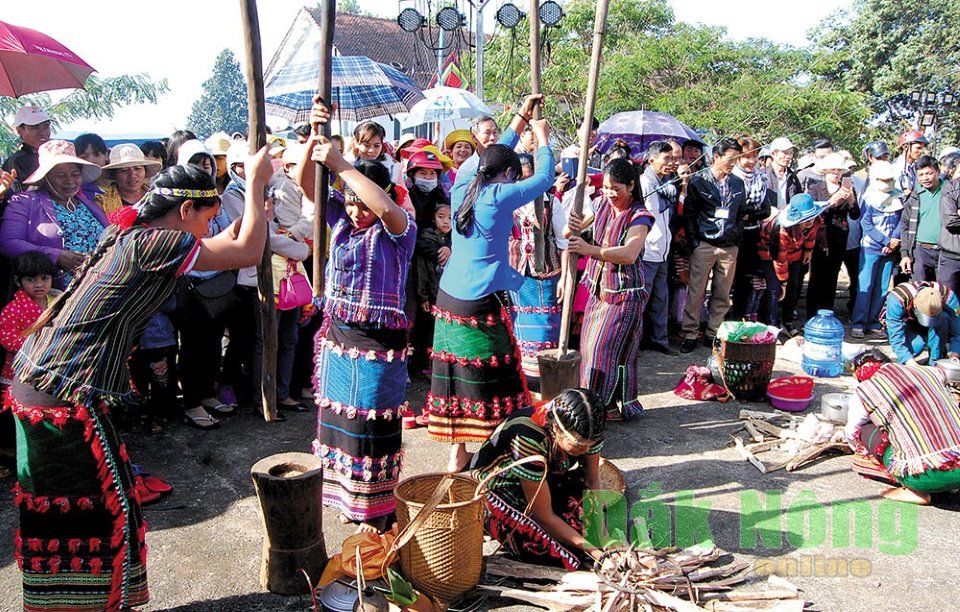
Besides putting a lot of efforts into economic development, Ma people (an indigenous ethnic minority group in Dak Nong) in Dak Nia commune, Gia Nghia town are very conscious of and pay a lot of attention to the presevation of their own unique values and cultural identity.
 |
| Ma people in the hamlet of N'rieng, Dak Nia commune, Gia Nghia town actively take part in the contests at festivals held in the local region. |
Keeping traditional jobs alive
The family of Mrs H'Bach and Mr K'Won could be given as an example as they still keep practicing the job of weaving brocades, then turn them into scarfs, blankets and clothings and sell them into the market. According to Mrs H'Bach, weaving brocades has been with her family for quite a long time, and despite the fact that the products sold out are not large in quantity, it has been considered by her family as an interest and a way of preserving traditional cultures.
In searching for the market to sell the products, the family has learned that Lam Dong province is the location inhabited by a large number of Ma people. It's also the place where community travelling activites are greatly developed. With the grasp of such insight, K'Won's family has introduced and deposited their products at tourism facilities in Lam Dong. As a result, their products has got to be known and increasingly loved by more and more people. As the orders for the products increase more and more, Mrs H'Bach and Mr K'Won had to ask their two daughters to join them in doing and keeping the job continued.
"People might have different ways of thinking but it is a pity to me to not keep preserving a long-lasting traditional job just because the makers are unable to sell their products. Instead, people should find out ways to keep the job existing while still being able to live on the it. That would be a worthwhile thing to do", said H'Bach.
Similarly, Mrs H'Grum opts to preserve the job of making Ruou Can (a wine that is fermented in a china jar and suck out of the jar by drinkers using pipes) from forests' yeast. Initially, she made Ruou can just to serve the need of her own family. Later, people in her village as well as other neighborhoods got to know about her product and like it, they began to order more and more. She then gathered the gut to buy materials and started making wine to sell to the market. With materials including rice, corn, cassava and kinds of traditional leaves and yeast collected from the forests, each year, she makes and sells out approximately 300 jars of Ruou Can.
"The main materials to make Ruou Can coming maily from rice, cassava and forests' leaves as yeast enable the wine keep its traditional taste and smell and that is possibly what makes it appeal to so many people. Though each person with each kind of job might have their own recipe to make products, following the traditional ways and methods would help people preserve cultural features while still developing products with their own uniqueness", said H'Grum.
Mr Y Bong in Phai Kon Prudang hamlet, though at 60 years of age, still looks for the masters to learn how to struck goongs and he himself teaches people how to blow traditional musical intruments. Given the fact that his family is not rich, he spent a comparatively large amount of money to buy musical instruments such as r'let, m'buot, goong reng to use and practice.
Mr Y Bong said that making those instruments is not difficult, but he still had to buy them because he did not know how to give them the sounds as he expected.
 |
| The use and performance of goongs are always upheld by the edlers and artists of Ma people |
Pillars of cultural activities.
Statistics show that Dak Nia commune is currently residential area of more than 380 households with over 1,500 people of Ma group, residing mainly in such hamlets as Bu Sop, N'jrieng, Se Re U, Phai Kon Prudang, Ting Wel Dom.
At present, each hamlet has set up a team for regularly practicing and performing folk songs and dances, in which, the artists with profound understanding of the group's traditional culture play the role as the nuclei and the leaders of the teams. On annual occasion of festivals or Tet, Ma people often actively take part in the cultural activities held by the local authority and people, for instance, Lieng Nung Spring festival, in which they organize and reappear a number of the traditional festivals.
At national and regional cultural contests, Ma people are also the pillars of the artists delegation, who take part in reappearing traditional festivals, introducing the group's cultural images to another ethnic minority group of the country.
The good news is that, Mrs H'Geng in the hamlet of Bu Sop, Mr K'Ngun in the hamlet of Ting Wel Dom have now had their name on the list included in the dossier that the provincial authority submitted to the Ministry of Culture, Sport and Tourism to request for the recognition of The Pepple's Artist. Particularly, Mr K'Tieng in the hamlet of N'jrieng was nominated for the recognition of The Pepople's Artist in the field of intangible cultural heritage, held the second time and in 2018.
Source:http://baodaknong.org.vn